AC voltmeters and ammeters
AC electromechanical meter movements come in
two basic arrangements: those based on DC movement designs,
and those engineered specifically for AC use.
Permanent-magnet moving coil (PMMC) meter movements will not
work correctly if directly connected to alternating current,
because the direction of needle movement will change with
each half-cycle of the AC. Permanent-magnet meter movements,
like permanent-magnet motors, are devices whose motion
depends on the polarity of the applied voltage (or, you can
think of it in terms of the direction of the current).

In order to use a DC-style meter movement
such as the D'Arsonval design, the alternating current must
be rectified into DC. This is most easily
accomplished through the use of devices called diodes.
We saw diodes used in an example circuit demonstrating the
creation of harmonic frequencies from a distorted (or
rectified) sine wave. Without going into elaborate detail
over how and why diodes work as they do, just remember that
they each act like a one-way valve for electrons to flow:
acting as a conductor for one polarity and an insulator for
another. Oddly enough, the arrowhead in each diode symbol
points against the permitted direction of electron
flow rather than with it as one might expect. Arranged in a
bridge, four diodes will serve to steer AC through the meter
movement in a constant direction throughout all portions of
the AC cycle:

Another strategy for a practical AC meter
movement is to redesign the movement without the inherent
polarity sensitivity of the DC types. This means avoiding
the use of permanent magnets. Probably the simplest design
is to use a nonmagnetized iron vane to move the needle
against spring tension, the vane being attracted toward a
stationary coil of wire energized by the AC quantity to be
measured.

Electrostatic attraction between two metal
plates separated by an air gap is an alternative mechanism
for generating a needle-moving force proportional to applied
voltage. This works just as well for AC as it does for DC,
or should I say, just as poorly! The forces involved are
very small, much smaller than the magnetic attraction
between an energized coil and an iron vane, and as such
these "electrostatic" meter movements tend to be fragile and
easily disturbed by physical movement. But, for some
high-voltage AC applications, the electrostatic movement is
an elegant technology. If nothing else, this technology
possesses the advantage of extremely high input impedance,
meaning that no current need be drawn from the circuit under
test. Also, electrostatic meter movements are capable of
measuring very high voltages without need for range
resistors or other, external apparatus.
When a sensitive meter movement needs to be
re-ranged to function as an AC voltmeter, series-connected
"multiplier" resistors and/or resistive voltage dividers may
be employed just as in DC meter design:

Capacitors may be used instead of resistors,
though, to make voltmeter divider circuits. This strategy
has the advantage of being non-dissipative (no true power
consumed and no heat produced):
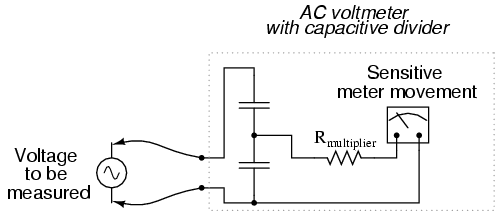
If the meter movement is electrostatic, and
thus inherently capacitive in nature, a single "multiplier"
capacitor may be connected in series to give it a greater
voltage measuring range, just as a series-connected
multiplier resistor gives a moving-coil (inherently
resistive) meter movement a greater voltage range:
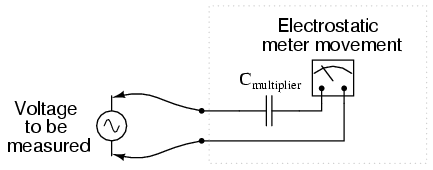
The Cathode Ray Tube (CRT) mentioned in the
DC metering chapter is ideally suited for measuring AC
voltages, especially if the electron beam is swept
side-to-side across the screen of the tube while the
measured AC voltage drives the beam up and down. A graphical
representation of the AC wave shape and not just a
measurement of magnitude can easily be had with such a
device. However, CRT's have the disadvantages of weight,
size, significant power consumption, and fragility (being
made of evacuated glass) working against them. For these
reasons, electromechanical AC meter movements still have a
place in practical usage.
With some of the advantages and
disadvantages of these meter movement technologies having
been discussed already, there is another factor crucially
important for the designer and user of AC metering
instruments to be aware of. This is the issue of RMS
measurement. As we already know, AC measurements are often
cast in a scale of DC power equivalence, called RMS (Root-Mean-Square)
for the sake of meaningful comparisons with DC and with
other AC waveforms of varying shape. None of the meter
movement technologies so far discussed inherently measure
the RMS value of an AC quantity. Meter movements relying on
the motion of a mechanical needle ("rectified" D'Arsonval,
iron-vane, and electrostatic) all tend to mechanically
average the instantaneous values into an overall average
value for the waveform. This average value is not
necessarily the same as RMS, although many times it is
mistaken as such. Average and RMS values rate against each
other as such for these three common waveform shapes:
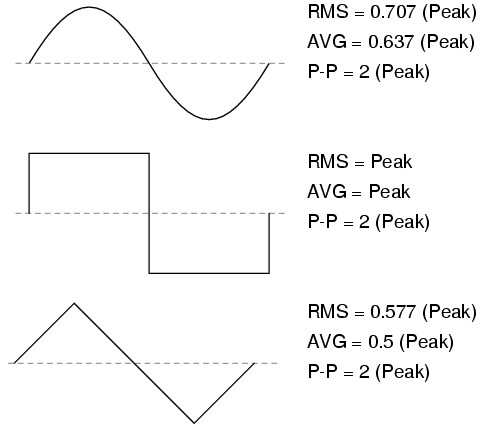
Since RMS seems to be the kind of
measurement most people are interested in obtaining with an
instrument, and electromechanical meter movements naturally
deliver average measurements rather than RMS, what
are AC meter designers to do? Cheat, of course! Typically
the assumption is made that the waveform shape to be
measured is going to be sine (by far the most common,
especially for power systems), and then the meter movement
scale is altered by the appropriate multiplication factor.
For sine waves we see that RMS is equal to 0.707 times the
peak value while Average is 0.637 times the peak, so we can
divide one figure by the other to obtain an average-to-RMS
conversion factor of 1.109:

In other words, the meter movement will be
calibrated to indicate approximately 1.11 times higher than
it would ordinarily (naturally) indicate with no special
accommodations. It must be stressed that this "cheat" only
works well when the meter is used to measure pure sine wave
sources. Note that for triangle waves, the ratio between RMS
and Average is not the same as for sine waves:

With square waves, the RMS and Average
values are identical! An AC meter calibrated to accurately
read RMS voltage or current on a pure sine wave will not
give the proper value while indicating the magnitude of
anything other than a perfect sine wave. This includes
triangle waves, square waves, or any kind of distorted sine
wave. With harmonics becoming an ever-present phenomenon in
large AC power systems, this matter of accurate RMS
measurement is no small matter.
The astute reader will note that I have
omitted the CRT "movement" from the RMS/Average discussion.
This is because a CRT with its practically weightless
electron beam "movement" displays the Peak (or Peak-to-Peak
if you wish) of an AC waveform rather than Average or RMS.
Still, a similar problem arises: how do you determine the
RMS value of a waveform from it? Conversion factors between
Peak and RMS only hold so long as the waveform falls neatly
into a known category of shape (sine, triangle, and square
are the only examples with Peak/RMS/Average conversion
factors given here!).
One answer is to design the meter movement
around the very definition of RMS: the effective heating
value of an AC voltage/current as it powers a resistive
load. Suppose that the AC source to be measured is connected
across a resistor of known value, and the heat output of
that resistor is measured with a device like a thermocouple.
This would provide a far more direct measurement means of
RMS than any conversion factor could, for it will work with
ANY waveform shape whatsoever:
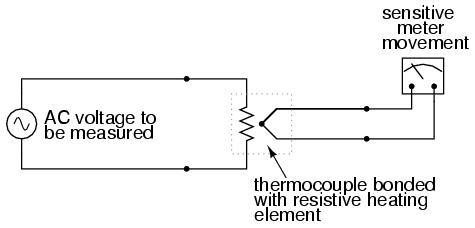
While the device shown above is somewhat
crude and would suffer from unique engineering problems of
its own, the concept illustrated is very sound. The resistor
converts the AC voltage or current quantity into a thermal
(heat) quantity, effectively squaring the values in
real-time. The system's mass works to average these values
by the principle of thermal inertia, and then the meter
scale itself is calibrated to give an indication based on
the square-root of the thermal measurement: perfect
Root-Mean-Square indication all in one device! In fact, one
major instrument manufacturer has implemented this technique
into its high-end line of handheld electronic multimeters
for "true-RMS" capability.
Calibrating AC voltmeters and ammeters for
different full-scale ranges of operation is much the same as
with DC instruments: series "multiplier" resistors are used
to give voltmeter movements higher range, and parallel
"shunt" resistors are used to allow ammeter movements to
measure currents beyond their natural range. However, we are
not limited to these techniques as we were with DC: because
we can to use transformers with AC, meter ranges can be
electromagnetically rather than resistively "stepped up" or
"stepped down," sometimes far beyond what resistors would
have practically allowed for. Potential Transformers (PT's)
and Current Transformers (CT's) are precision instrument
devices manufactured to produce very precise ratios of
transformation between primary and secondary windings. They
can allow small, simple AC meter movements to indicate
extremely high voltages and currents in power systems with
accuracy and complete electrical isolation (something
multiplier and shunt resistors could never do):
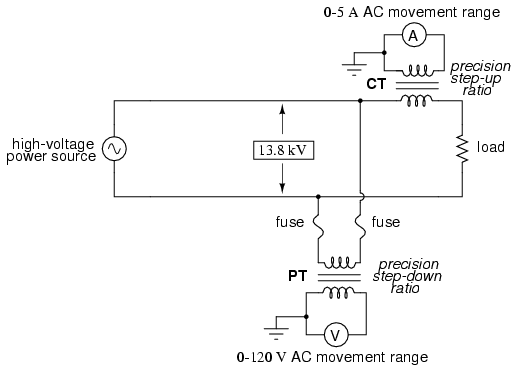
Shown here is a voltage and current meter
panel from a three-phase AC system. The three "donut"
current transformers (CTs) can be seen in the rear of the
panel. Three AC ammeters (rated 5 amps full-scale deflection
each) on the front of the panel indicate current through
each conductor going through a CT. As this panel has been
removed from service, there are no current-carrying
conductors threaded through the center of the CT "donuts"
anymore:
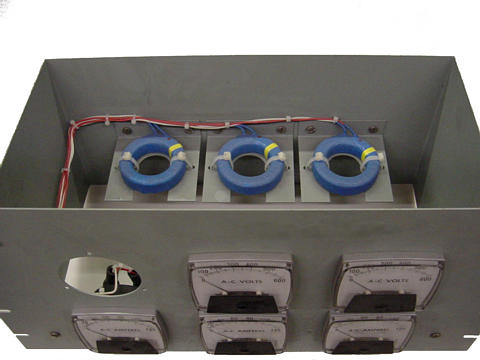
Because of the expense (and often large
size) of instrument transformers, they are not used to scale
AC meters for any applications other than high voltage and
high current. For scaling a milliamp or microamp movement to
a range of 120 volts or 5 amps, normal precision resistors
(multipliers and shunts) are used, just as with DC.
-
REVIEW:
-
Polarized (DC) meter movements must use
devices called diodes to be able to indicate AC
quantities.
-
Electromechanical meter movements, whether
electromagnetic or electrostatic, naturally provide the
average value of a measured AC quantity. These
instruments may be ranged to indicate RMS value, but only
if the shape of the AC waveform is precisely known
beforehand!
-
So-called true RMS meters use
different technology to provide indications representing
the actual RMS (rather than skewed average or peak) of an
AC waveform.
|